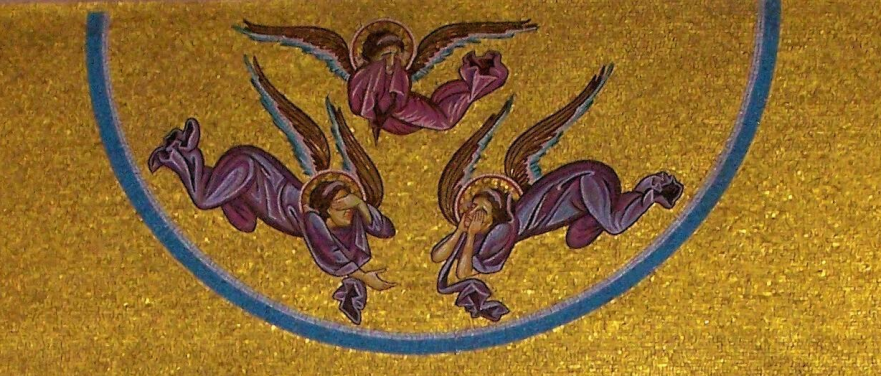Yet, another reality coexists with this present evil, just as it did on the first Christmas, when human misery also abounded—the reality of goodness. Today, many people struggle to be selfless and caring, maintaining a life of integrity and self-control in spite of countless obstacles. That, too, is real. And though the first Christmas led inexorably to the horror of Good Friday’s cross, it also led to Jesus’ ultimate triumph of good over evil on Easter.

An angel with drawn swords guards a locked door in an illumination from the Orthodox church in Capernaum. Photo courtesy of Joshua N. Tilton.
Perhaps it’s noteworthy that the Gospel stories of Christmas and Easter share a link that catches our attention, especially during these disconcerting times. Both stories tell of our spiritual companions, angels. At the time of these events, angels acted as messengers. Christmas angels announced Jesus’ birth with joy, almost a catchy jubilance. Easter angels announced his resurrection with a calm, somber serenity that substantiated its almost unthinkable truth.
In the Hebrew Scripture, angels are often portrayed as protectors; for example, they saved Lot and his family (Gen. 19:15) and delivered three men from a fiery furnace (Dan. 3:28). Angels comforted Jesus after his temptations in the desert (Matt. 4:11) and during his agony in the garden (Luke 22:43). In Revelation 12:7-8, they appear as warriors. Three angels are named: Michael (Jude 9; Rev. 12:7), Gabriel (Dan. 8:16; 9:21; Luke 1:19, 26), and Raphael (Tob. 12:15). Jesus himself said that children’s angels “continually see the face of my Father in heaven” (Matt. 18:10).
The angels in Scripture have a relentless message: “Fear not.” We see this from “Do not be afraid, Mary, for you have found favor with God” (Luke 1:30) to “Joseph, son of David, do not be afraid to take Mary as your wife” (Matt. 1:20). Again, in Luke 2:10, the angel said to the awestruck shepherds, “Do not be afraid; for see—I am bringing you good news of great joy for all the people.” Years later, as the first Easter dawned, an angel assured the terrified women at Jesus’ tomb, “Do not be afraid” (Matt. 28:1-7).
Skipping ahead to Acts 12:6-11, we read how an angel, almost playfully, helped Peter escape from his prison cell. Suddenly appearing in light, the angel “tapped Peter on the side and woke him, saying, ‘Get up quickly.’ And the chains fell off his wrists.” Peter dressed and followed the angel out, but “did not realize that what was happening with the angel’s help was real; he thought he was seeing a vision.” Undetected, they passed the guards. The iron city gate “opened for them of its own accord, and they went outside and walked along a lane, when suddenly the angel left him. Then Peter came to himself and said, ‘Now I am sure that the Lord has sent his angel and rescued me.’” I shake my head in disbelief along with Peter. Am I dreaming? No, it happened.

Depiction of an angelic being from the Hagia Sophia in Istanbul. Photo by Beate Paland courtesy of Wikimedia Commons.
Paul, too, encountered an angel while a prisoner aboard a ship bound for Rome (Acts 27:22-26). Caught in a wild storm, the passengers and crew feared for their lives. Paul stood and, with a boldness born of Truth, told the men that “an angel of the God to whom I belong and whom I worship” had appeared to him the night before and said, “Do not be afraid, Paul; you must stand before the emperor; and indeed, God has granted safety to all those who are sailing with you.” I picture those rough seamen staring wide-eyed at Paul before they lunged at this madman in their midst, and I cringe for him. But that safe landing, too, came to pass.
“Do not be afraid.” The powerful certainty that emanates from these otherworldly beings grips and bolsters us. Moreover, their encouraging words are followed with answers to “Why shouldn’t we be afraid?”—answers that point to their Creator and ours, in whose hands lies the future. Mary will be the Mother of God. Joseph will safeguard that Son.

Angels weep at the burial of Jesus in a mosaic from the Church of the Holy Sepulchre in Jerusalem. Photo courtesy of Joshua N. Tilton.
The shepherds will share the good news. Peter will lead the early church. Paul will give witness in Rome. God has a purpose for each of us and, until that purpose is fulfilled, we will walk through flames unscathed.
Though overshadowed by evil, we continue to fight our daily inward battles, striving to live with awareness of God’s presence, courage, gratitude, and love for all. It’s comforting to know that, beside us as we journey, are the angels—Heaven’s invisible messengers and our guides, guardians, and fellow warriors.





